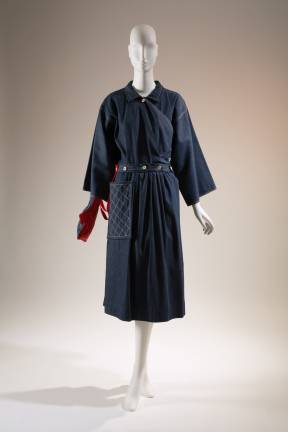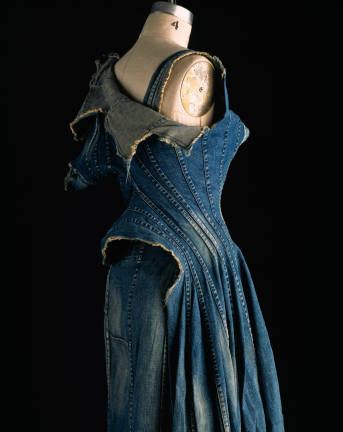Denim through the Ages


In 2000, Time Magazine crowned Levi’s 501 blue jeans the “Fashion Item of the 20th Century.” The sturdy denim fabric, a cotton twill textile, has clothed California gold rush miners, prisoners, cowboys, sailors, actors, hippies, presidents (remember Barack Obama in “mom jeans”?), Brooke Shields and, hilariously, Britney Spears and Justin Timberlake on the red carpet at the 2001 American Music Awards.
“You want to know what comes between me and my Calvins? Nothing,” a 15-year-old Shields purred in that racy Calvin Klein ad in 1980. Klein was matter-of-fact about the campaign: “Jeans are sex,” he said. “The tighter they are, the better they sell.”
The ad appears on a small video screen here and, along with the famous jingle for Jordache Jeans (“You’ve Got The Look”), functions as a kind of white noise at this very blue show, “Denim: Fashion’s Frontier.” The exhibit pays homage to the ubiquitous fabric’s history, while underscoring its high-fashion appeal and endless capacity for reinvention.
“It is not just a history of blue jeans,” curator Emma McClendon said in an email, referring to the textile’s versatility.
Inspired by research for a recent show on ‘70s fashion, when denim ruled, McClendon opens with a pair of classic Levi Strauss 501s from the ‘50s — the style of the company’s original, patented, five-pocket riveted denim “work pants” from 1873—and concludes with couture riffs, such as Tom Ford’s $3000 feathered trousers for Gucci and Junya Watanabe’s evening gown for Comme des Garçons.
In between there’s a decade-by-decade parade of cultural markers in the form of work shirts, walking suits, jackets, vests, uniforms, poodle skirts, jumpsuits, leisure suits, embroidered jeans, patched jeans, distressed jeans, bleached jeans, stone-washed jeans, photo-printed jeans, tight jeans, baggy jeans, short jeans, flared jeans, and denim bathing suits and clogs.
Name a historical period from roughly the mid-19th century on and denim was there, adapting to, and reflecting, the times. McClendon, author of a forthcoming book on the subject due out in April, presents more than 70 outfits that reflect on the culture and symbolize aspirations, some lofty, some not.
“One detail I hope visitors remember is that denim did not begin as a menswear textile only, and has in fact appeared in women’s clothing since the 19th century,” she said, referring to the 1850 woman’s work jacket at the beginning of the show.
Fast-forward to the next century and to the war effort in the 1940s when some three million women went to work in factories and shipyards and wore denim jumpsuits (cue “Rosie the Riveter”). American designer Claire McCardell created the sensible “Popover” dress in 1942 for fashionable stay-at-homes, who did their own housework and needed a practical, durable garment. The dress, with oven mitt for Mom, was advertised in “Harper’s Bazaar” with the slogan, “I’m doing my own work.” See it here.
In the ‘50s, denim came to symbolize rebellion and delinquency — think Marlon Brando in “The Wild One” and James Dean in “Rebel Without A Cause.” Many school districts banned jeans as a consequence, and the industry responded with the formation of The Denim Council, which produced ads (“Right for School”) to counter the negative stereotype.
In the next decade, denim was embraced by the counterculture, becoming an emblem of the hippies, who wore bell-bottomed “pre-owned” jeans with hand embellishments and anti-establishment defiance.
The fabric morphed in succeeding years, representing the culture of consumerism (enter designer labels), punk, hip-hop, prison, gang and luxury — more of it, in the 2000s.
One of the most important developments in the industry over the last 30 years, the curator said, has been the introduction of “finishing” treatments (stone-washing, acid-washing, distressing and the like) and the subsequent “environmental fallout of these processes during the late 1990s and early 2000s, and then the search for more sustainable ways to create the same effects (through the use of lasers, ozone gas, etc.) in the 21st century.”
Two of McClendon’s favorite pieces from the show: “Two pairs of jeans given to the museum by Francois Girbaud. One pair dates to approximately 1985, and the other is from about 2010. The earlier pair is stonewashed — a technique Girbaud was known for pioneering in the 1980s. The later pair is distressed with a laser.”
Anthropologists Daniel Miller and Sophie Woodward have posited that almost half the population is wearing jeans each day. But the popularity of athleisure (sports wear that doubles as leisure wear) begs the question: Can denim survive the competition?
The curator acknowledged the “challenge” for the domestic market, but maintains, “Denim has a cultural legacy … which athleisure cannot compete with. I also think denim has a global reach far beyond athleisure, to virtually every country and culture in the world.”
Her hope is that visitors “will see both pieces they recognize and relate to, but also be surprised and learn something new.”